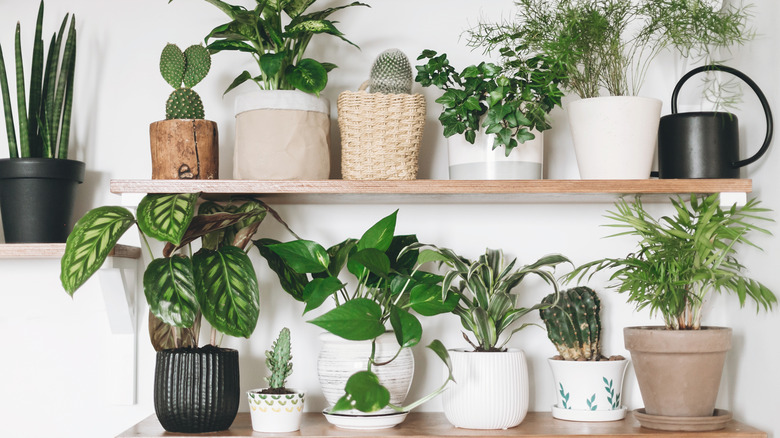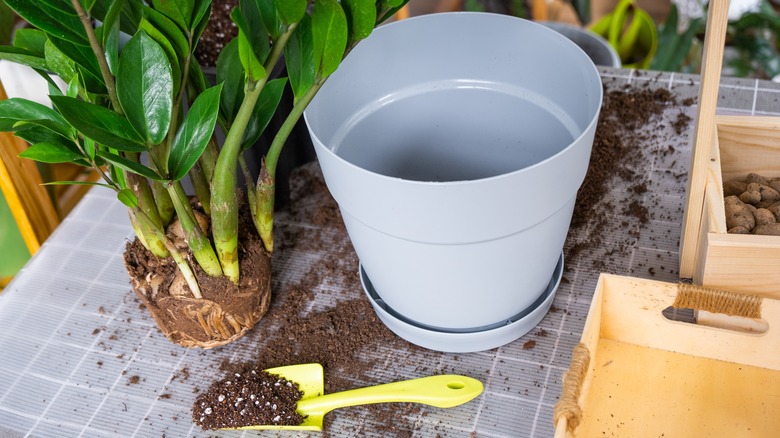How To Replicate TikTok's Viral 'Plant Toilet' For Happy And Healthy Houseplants
We may receive a commission on purchases made from links.
A "plant toilet," you say? What even is that? Well, it's probably not what you're picturing. We're not talking about upcycling your old toilet as a ceramic planter for your houseplants, though it would certainly be a conversation piece if you featured it in your living room. A plant toilet is a TikTok trend and DIY tool that helps plant enthusiasts water and repot their plants without creating a mess in their home. It appears to be a great alternative to those who want but can't afford to purchase a sink or vanity to use specifically for gardening purposes. That being said, it does require some handiwork and thrifting skills in order to secure all of the materials.
Most importantly, you'll need to choose a sturdy bowl for your plant toilet. The bowl will serve as the basin in which you water or repot your plants. Eventually, you'll need to drill a hole in the middle to allow water and soil to flush out, hence the "toilet" moniker. A large ceramic or porcelain bowl would do and can be rather affordable if you thrift it. Regardless, you'll also need to invest in a diamond drill bit in order to safely create a drainage hole in most materials.
Additionally, you'll need to secure some scrap lumber to build the foundation around the basin, plus screws, a drill, a drainage bucket, and any wood stain should you want to add a personal touch to your new plant toilet.
How to construct your plant toilet
Once you've secured all of your materials, it's time to start building. To begin, drill a hole in the middle of your bowl in order to add a drainage hole in your plant toilet. Use your diamond drill bit according to the directions on the packaging in order to safely cut through sensitive and fragile materials.
After you've created the drainage hole, you're ready to start on the foundation. For the top layer, a sheet of plywood or sturdy scrap wood that is longer and wider than the bowl will do. Using a circular saw, cut a round hole in the middle of the wood that is large enough for the bowl to rest in, providing support around the edge of the bowl for it to rest comfortably in the hole.
Finally, you'll attach legs to complete your project. Four equal-length pieces of 2 x 4-inch boards will suffice. Depending on your woodworking skills, the method you use to attach the legs will depend on your expertise. For beginners, Home Depot claims that a butt joint is the easiest way to attach wood together with screws, but it is also the weakest. If you have particularly heavy plants, you may consider more advanced joints or cross braces for supporting your plant toilet. Alternatively, you could also rest the basin table on sawhorses or some other sturdy platform without the need to affix permanent legs to the structure.
The benefits of using a plant toilet
For those who don't have the patience or mindset for woodworking or DIY creations, this project may be best left to those who do. But if this is within your wheelhouse of skills, then it can be a fun and creative way to create a new gardening station that offers a myriad of benefits to your plants.
Most importantly, this plant toilet can assist you in watering your plants thoroughly without worrying about the drainage trays overflowing onto your flooring. Instead, the water flows through the drainage hole in the basin into a bucket below. This bucket can then be used to water your other plants outside, eliminating water waste. Be sure, however, not to water other plants with water that came from a diseased or infested plant as it will likely infect other plants in your garden.
Another benefit of the plant toilet is that it keeps your home clean. Repotting or watering potted plants in your home often results in a mess. Gardening is quite literally a dirty hobby. Between watering your plants in the sink, or sifting soil on the kitchen counter, your interior is likely to become a victim of your hard work. Moving these activities to a plant toilet outside, whether it's in a garage, shed, or greenhouse, eliminates the need to involve your clean home. Instead, you'll have a dedicated gardening workspace that your plants will love.

